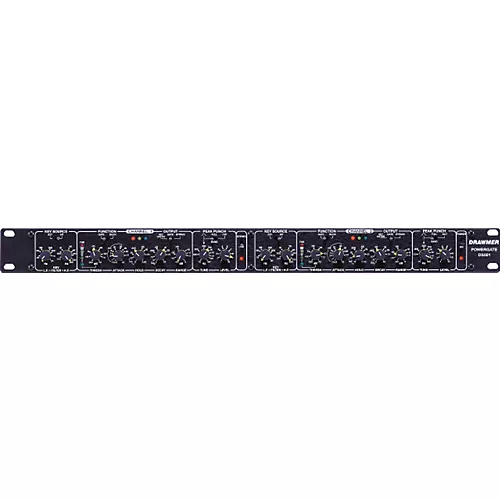Drawmer DS501 Power Gate
Quantity
-
DetailThe DS501 is a sophisticated dual channel noise gate with fully tuneable Peak Punch incorporating a number of features pioneered by Drawmer, which are invaluable to the sound engineer, and not found on conventional noise gates. Positioned in the Drawmer range over the industry standard DS201 Dual Gate, the DS501 Power Gate features a new dual mode tuneable Peak Punch processing section on each channel. In tuneable mode a fully variable frequency selector with a range from 75Hz to 16kHz allows the user to shape the transients of the gated signal and 'tune-in' to the particular area of the audio spectrum where the Peak Punch is to be active. In addition a variable 'more' control allows the user to tailor the amount of processing. A secondary Full Band Peak Punch mode is also available. Designed principally for drum and percussive gating applications, tuneable Peak Punch makes it possible to add transient punch to frequencies lacking in individual drum sounds, adding greater definition and presence to the gated signal. Using low frequency Peak Punch adds depth to thin drums, whilst higher frequency Peak Punch can dynamically emphasise rim shots or the 'crack' of a snare drum. Setting up noise gates can be tedious and unrewarding. For example, when attempting to separate a signal from unwanted noise or crosstalk that is relatively high in level, spurious triggering of the gate by unwanted components within the sound can be a serious problem. This can often be experienced in the studio when recording a drum kit. If a gate is used to clean up the snare drum sound it is quite likely that the nearby hi-hats will spill into the snare drum microphone and cause the gate to open. Increasing the threshold level may cure this problem, but then there is a very real danger that any quieter snare drum beats may not cause the gate to open at all and the performance can easily be ruined. The DRAWMER solution to this problem is the inclusion of two variable filters, one high-pass and one low-pass, which act upon the side-chain keying circuitry. By setting the output switch to key listen the user can hear the action of the filters and adjust them to reject high frequency spillage from the hi-hats. This now enables the gate to only open on the lower frequencies present in the snare drum. The very fast attack of the DS501 means that it can open in a matter of micro seconds, thus preserving the natural attack of whatever sound is being gated and the comprehensive envelope controls mean that the gain can be changed at whatever rate best suits the material being processed. With vocals for example, a fairly fast attack is needed so as not to clip the leading consonants but a slower release time will prevent the end of words being clipped off and will also fade out any noise gradually rather than cutting it off abruptly. This latter point is very important as the human ear is far more sensitive to rapidly changing noise levels than to a constant low level noise. Another important role played by the gate is in the reshaping of existing sounds. An example of this might involve a simple sampling delay line used to store a sound to be re-triggered later and added to a mix. A gate can be used to impart a slower attack or faster decay to the sound and careful setting of the decay envelope can effectively hide any noise present at the end of the sample. When using a sampler or drum machine the gate can be considered a triggered envelope shaper, and the wide range allowed by the envelope controls make the DS501 ideal for this application. The unit can be switched to accept a key input, which allows the gate to be triggered externally. An example of this would be to use a snare drum signal to open the gate on a separate ambient microphone to create a natural alternative to gated reverb. Each channel can be individually switched from Gating to Ducking for 'voice over' applications or the removal of 'clicks' and 'pops'.
-
Customer ReviewsNo comments

 Fender
Fender Gibson
Gibson Taylor
Taylor Martin
Martin lbanez
lbanez Epiphone
Epiphone PRS
PRS Schecter Guitar Research
Schecter Guitar Research Fender Stratocaster
Fender Stratocaster Fender Telecaster
Fender Telecaster Gibson Les Paul
Gibson Les Paul Gibson SG
Gibson SG lbanez RG
lbanez RG Taylor American Dream
Taylor American Dream Taylor GS Mini
Taylor GS Mini Martin GPC
Martin GPC lbanez
lbanez Fender
Fender Squier
Squier Ernie Ball Music Man
Ernie Ball Music Man Sterling by Music Man
Sterling by Music Man Rickenbacker
Rickenbacker Sire
Sire Schecter Guitar Research
Schecter Guitar Research Fender Precision Bass
Fender Precision Bass Fender Jazz Bass
Fender Jazz Bass Fender Mustang
Fender Mustang lbanez SR
lbanez SR Strandberg Boden
Strandberg Boden Yamaha TRBX
Yamaha TRBX Yamaha BB
Yamaha BB Schecter Stiletto
Schecter Stiletto Fender
Fender Marshall
Marshall Orange Amplifiers
Orange Amplifiers Markbass
Markbass Boss
Boss Blackstar
Blackstar Kemper
Kemper Vox
Vox Line 6
Line 6 Electro-Harmonix
Electro-Harmonix MXR
MXR Meris
Meris Dunlop
Dunlop EarthQuaker Devices
EarthQuaker Devices lbanez
lbanez TC Electronic
TC Electronic Alesis
Alesis Roland
Roland Zildjian
Zildjian DW
DW Simmons
Simmons Meinl
Meinl Remo
Remo TAMA
TAMA Pearl
Pearl Vic Firth
Vic Firth Sound Percussion Labs
Sound Percussion Labs Evans
Evans Sabian
Sabian Lp
Lp Yamaha
Yamaha Yamaha
Yamaha Roland
Roland Korg
Korg Williams
Williams Akai Professiona
Akai Professiona Casio
Casio Nord
Nord Moog
Moog Williams Legato
Williams Legato Yamaha Clavinova
Yamaha Clavinova Harbinger
Harbinger Bose
Bose JBL
JBL Electro-Voice
Electro-Voice Behringer
Behringer Yamaha
Yamaha Mackie
Mackie JBL EON
JBL EON Bose L1 Pro
Bose L1 Pro QSC K Series
QSC K Series Yamaha Mixers
Yamaha Mixers Harbinger VAR!
Harbinger VAR! Focusrite
Focusrite Universal Audio
Universal Audio Yamaha
Yamaha PreSonus
PreSonus Tascam
Tascam KRK
KRK Rode
Rode Focusrite Scarlett
Focusrite Scarlett Universal Audio Apollo
Universal Audio Apollo Shure
Shure Sennheiser
Sennheiser AKG
AKG Neumann
Neumann Rode
Rode Sterling Audio
Sterling Audio Audio-Technica
Audio-Technica Warm Audio
Warm Audio AKG 414
AKG 414 Musician Geal
Musician Geal Fender
Fender D'Addario
D'Addario Ernie Ball
Ernie Ball Elixir
Elixir Road Runner
Road Runner Gator
Gator Proline
Proline Remo
Remo Livewire
Livewire On-Stage
On-Stage Hercules
Hercules Mogami
Mogami Dunlop
Dunlop Perri's
Perri's Snark
Snark
